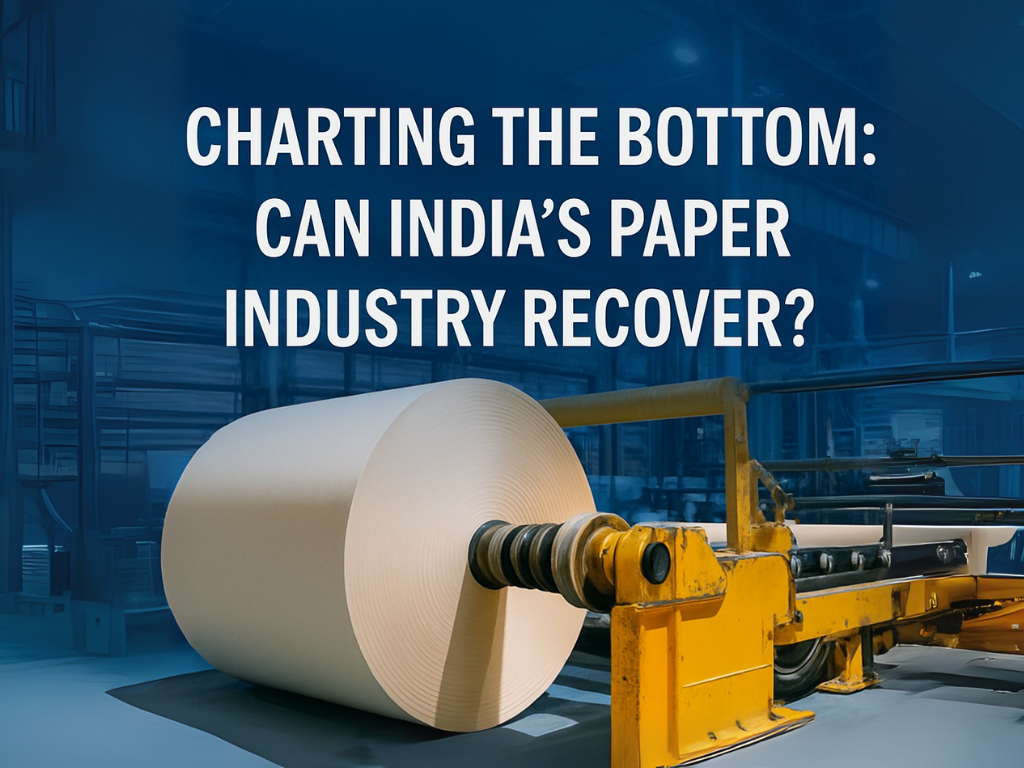CHARTING THE BOTTOM: CAN INDIA’S PAPER INDUSTRY RECOVER?
Margins are tight, imports are surging, and input costs are spiraling, yet the Indian paper industry is still running at near full capacity. Could this be the classic bottom before the bounce?
India’s paper sector is facing a convergence of pressure points. EBITDA margins have dropped to 6.9% in Q3 FY25, a far cry from the long-term average of 16.6%. It’s the lowest the industry has seen in two decades, according to research by BOB Caps. But beneath the stress lies a story of survival and potential revival.
WHAT’S GONE WRONG?
The pain points are clear:
- Cheaper imports from China and Indonesia continue to undercut domestic pricing.
- Timber prices have surged, driven by competing demand from MDF and particleboard players.
- Domestic paper demand has softened, adding to the margin squeeze.
Yet, despite these headwinds, paper mills in India are operating at 98% capacity, an astonishing figure given the margin erosion. It’s a reflection of both the sector’s fixed-cost nature and its confidence in long-term demand recovery.
THE CASE FOR A TURNAROUND
Is this as bad as it gets? Some analysts believe so. BOB Caps suggests that the industry may be at the bottom of its cyclical trough, with room for gradual recovery over the next 12–18 months.
Here’s why that view holds ground:
- Global pulp prices, a major input driver, are expected to stabilise by end-2025.
- A weaker rupee could make imports less attractive, supporting domestic prices.
- Timber prices may cool down, thanks to increasing plantation efforts.
On the financial front, there’s more good news. The top 10 listed companies have dramatically reduced leverage, bringing net debt to EBITDA down from 4.6x in FY14 to just 0.3x in FY24. That gives them enough headroom to absorb short-term shocks.
NO MORE EXPANSION, AND THAT’S A GOOD THING
One difference this time around? Capacity addition is on pause. Between FY11 and FY14, the industry added significant capacity, only to face a brutal oversupply problem. That mistake isn’t being repeated. With major players like BILT and TNPL constrained by weak balance sheets and the cost of a brownfield paper plant estimated at ₹20,000–₹25,000 crore, expansion is off the table for now.
This could create a tight but more stable supply environment, especially if demand recovers in phases.
WHERE THE OPPORTUNITY LIES
A subtle but important shift is also underway: the pivot to paperboard. As traditional paper sees slower growth, many companies are redirecting focus toward packaging board, a segment with higher margins and better long-term prospects.
Market share consolidation is also expected to continue, with financially sound players like JK Paper poised to gain ground.
CLOSING THOUGHTS: PAIN BEFORE PROGRESS
Yes, the Indian paper industry is in a tough spot. But unlike in past cycles, it now has stronger balance sheets, leaner operations, and a clearer understanding of demand dynamics. If pulp prices hold steady and policy remains favourable, a recovery in margins may just be around the corner.
At Coniferous, we remain committed to tracking these shifts closely, supporting our partners with timely insights and reliable supply, no matter where the cycle stands.


